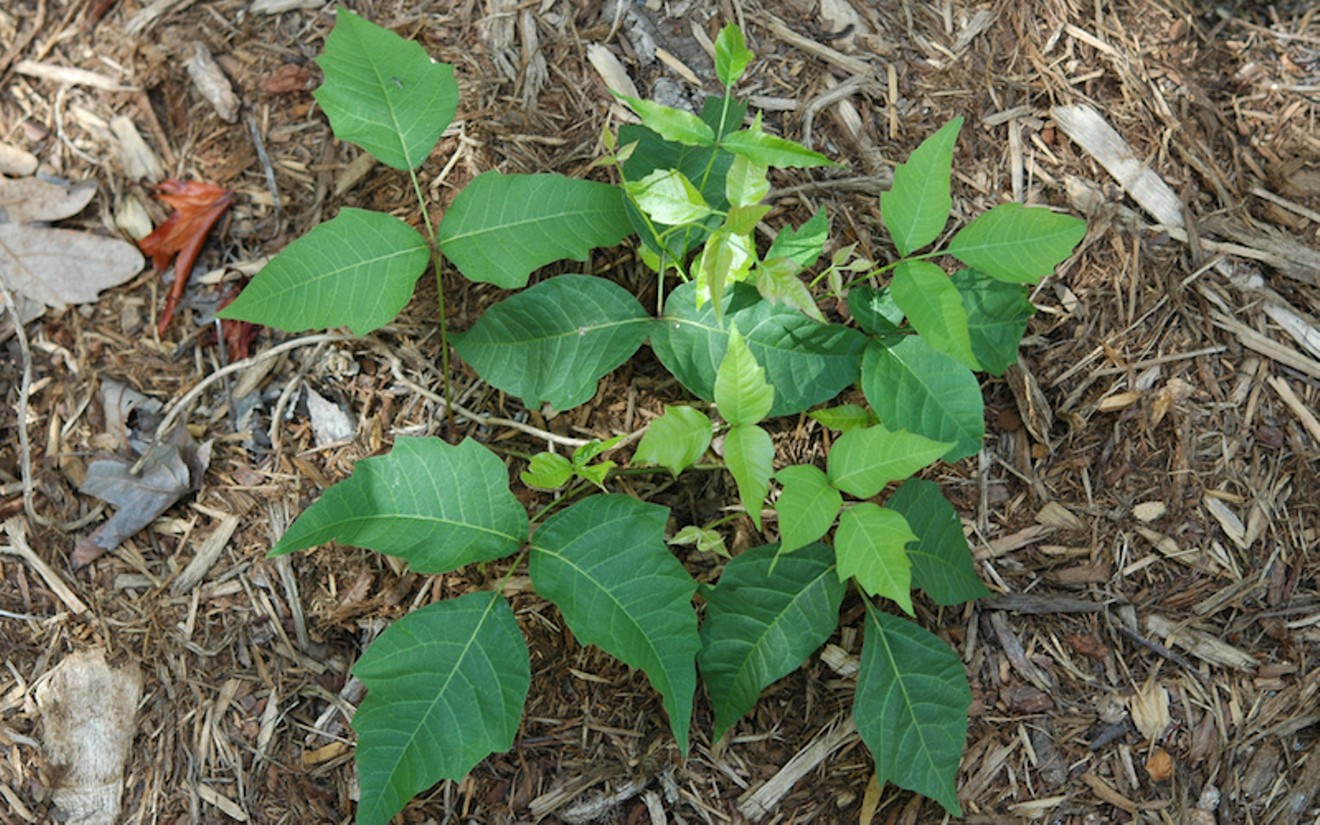5. POISON IVY
We might as well get this out of the way first, because when most people think of a nuisance plant, poison ivy is one of the first things that come to mind. It grows throughout every part of Texas except for the Western Panhandle, and at one time or another, almost all of us have stumbled across it. Poison Ivy typically has three-leaf clusters extending from a single stem, although occasionally it can have five. It can appear as a trailing or climbing vine, or as a small bush or tree. Its appearance can change throughout the seasons, and it will often feature small greenish-white flowers in the spring, and white berries in the fall.
Contact with poison ivy can cause symptoms to appear within 12 to 36 hours after exposure, which typically manifests as an itchy, burning rash and small blisters over the affected area. In extreme cases, the blisters may be large and swelling can develop. As with most outdoorsy things we'd like to avoid, the best way to steer clear of poison ivy is to learn how to identify it. If a person finds himself in an area where he's likely to encounter the plant, he should wash all his clothes if there's a chance the ivy has come into contact with them. Skin exposed to poison ivy should be washed as soon as possible with soap and large amounts of water. To minimize discomfort, the skin should be kept clean and dry, and hydrocortisone creams can be applied. In the case of a major outbreak of symptoms, it's a good idea to seek professional medical care.
4. TEXAS BULLNETTLE
This perennial flowering herb flowers year round, and grows throughout the eastern half of the state, including Houston and the surrounding area. My research indicates that the odd-looking plant is even used by some folks in landscaping and xeriscaping, but most people would probably prefer to avoid it if possible. It tends to grow in loose soil that's well exposed to the sun, and can reach more than two feet tall and three feet across, although many bullnettles are much smaller. Its stem, leaves and branches are covered with bristles that release a toxic irritant upon contact, giving the plant a painful sting that can last more than an hour for a victim unfortunate enough to touch one. A mixture of baking soda and water will create an acid neutralizing paste that can provide some relief.
There are other stinging nettles in Texas, but they resemble the Bullnettle, and the treatment for symptoms remains the same — a mixture of baking soda and water or application of hydrocortisone creams or lotions to provide relief from discomfort.
3. POISON SUMAC
Mainly found in wooded, wet areas in East Texas, poison sumac looks different from poison ivy, but has much the same effect on anyone who comes into contact with it. The plant often resembles a small tree or shrub, and its leaves appear as three to six pairs branching out from a stem, which typically has a final leaf at the stem's end. Skin exposure to poison sumac should be treated the same way as poison ivy.
2. POISON HEMLOCK
This invasive species is bad news, and was once used in ancient Greece as an execution method. It can be found in the southern part of the state, and can be deadly if ingested by people or animals (just ask Socrates), so it's best to eliminate this dangerous pest plant if one finds it growing on his or her property. Anyone who ingests poison hemlock should seek immediate emergency medical care. One Aggie website describes poison hemlock this way:
A biennial of the parsley family. It has stout, erect, hollow stems that may be purple streaked or splotched and may grow up to 10 feet tall. Leaves can be 6 inches wide and 12 inches long, with many oval to broadly oval leaflets opposite each other. The leaf stems clasp the main stem at their junction. White flowers are arranged in umbrella-shaped clusters.
1. WATCH THOSE FLOWERBEDS
There are a lot of poisonous plants growing in Texas, and quite a few are popular in landscaping and other decorative uses. While most of these pose little threat to most adults, since few of us are foraging for a meal in our flowerbeds, they can be dangerous to children and pets. Plants like Elephant Ear and Lily of the Valley can be extremely dangerous if ingested, and they're just the tip of the iceberg. Rather than attempting a comprehensive list of all poisonous plants, here's a good one from Poison Control's website, which also has some good preventative strategies to read.






